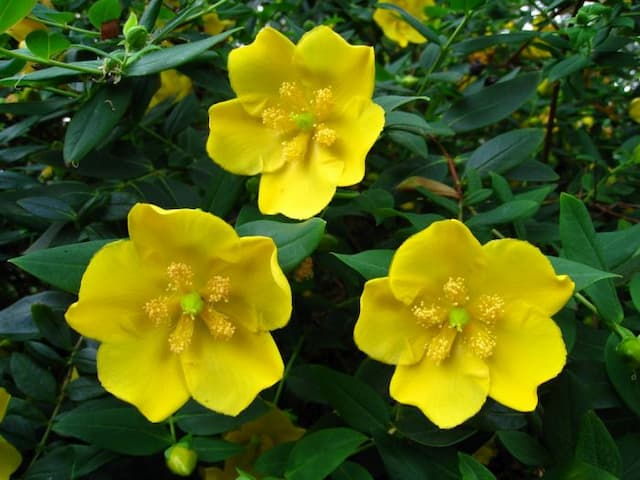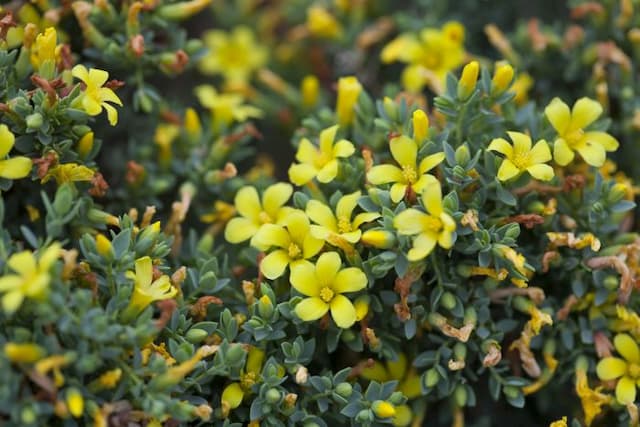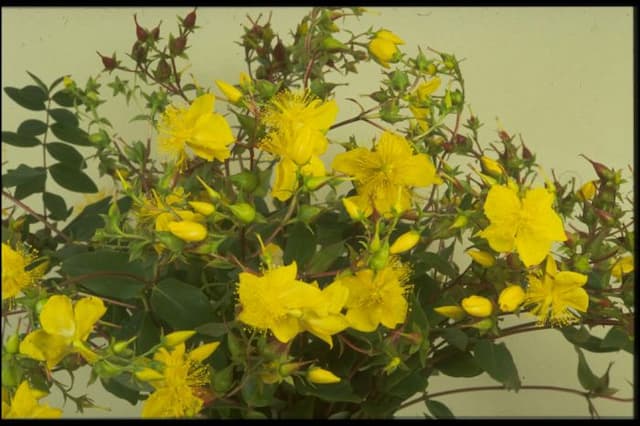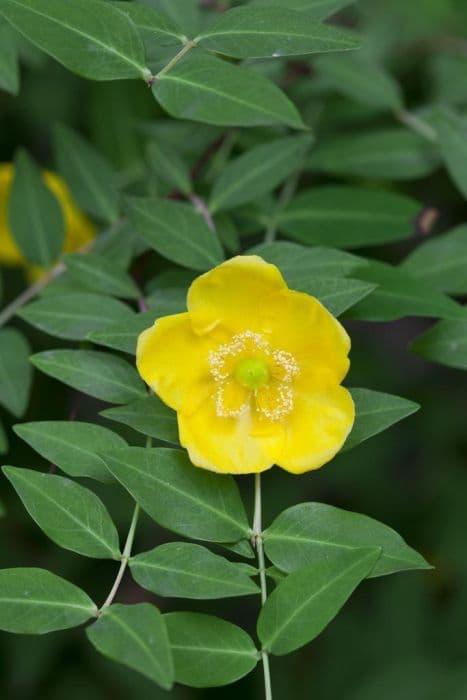St John's wort Hypericum perforatum

ABOUT
The plant under discussion is commonly known as St. John's Wort. It is a flowering plant characterized by its bright yellow flowers, which typically feature five petals dotted with black or dark red spots along the margins. These spots can sometimes give the appearance of perforations, lending to the "perforatum" in its name. The flowers are borne in dense, broad clusters at the ends of its upright stems. St. John's Wort has numerous stamens which are prominent in its flowers, often giving a bushy appearance. The leaves are another distinctive feature, being small, oval-shaped, and displaying a somewhat translucent quality when held against the light. If you look closely, the leaves appear to be perforated due to the presence of oil glands that are visible as light spots. These glands contain the plant's aromatic oils, which are released when the leaves or flowers are crushed. The plant has a shrubby form with numerous reddish stems splaying outwards. The leaves and stems, when broken, can exude a reddish pigment, which combined with the yellow of the flowers, can make for a striking contrast. The overall impression of St. John's Wort is one of a hardy, bushy plant with a profusion of sunny yellow flowers that can enliven any setting where it grows.
About this plant
 Names
NamesFamily
Hypericaceae
Synonyms
Saint John's Wort, Tipton's Weed, Chase-devil, Goatweed, Klamath Weed, Touch-and-heal, Rosin Rose
Common names
Hypericum vulgare, Hypericum officinale, Hypericum pyrifolium, Hypericum lineolatum, Hypericum lineatum.
 Characteristics
CharacteristicsLife cycle
Perennials
Foliage type
Deciduous
Color of leaves
Green
Flower color
Yellow
Height
1-3 feet (0.3-0.9 meters)
Spread
1-2 feet (0.3-0.6 meters)
Plant type
Herb
Hardiness zones
5-9
Native area
Europe
Benefits
 General Benefits
General Benefits- Mood Elevation: Traditionally associated with an uplifting effect on the mood.
- Decorative Uses: The bright yellow flowers add aesthetic value when used in gardens or as ornamental plants.
- Attracts Pollinators: It is known to attract beneficial insects like bees and butterflies, which are essential for pollination.
- Dye Production: Historically used to create red and yellow dyes for fabrics.
- Crafting and Floral Arrangements: Can be used in dried floral arrangements and other craft projects.
- Herbal Preparations: Common ingredient in herbal teas and oil infusions.
- Culinary Uses: Occasionally used as a flavoring agent in foods and beverages.
- Garden Use: As a perennial, it can provide structure to garden designs.
- Traditional Celebrations: Associated with St. John's Day and reportedly used to ward off evil spirits in folk traditions.
 Medical Properties
Medical Properties- Antidepressant: Hypericum perforatum, commonly known as St. John's wort, is widely used for its potential effects in treating mild to moderate depression.
- Anti-inflammatory: The plant contains active components that may reduce inflammation, contributing to its use in treating conditions with an inflammatory component.
- Antiviral: Research suggests St. John's wort exhibits antiviral activity, potentially effective against some viral infections.
- Antibacterial: The plant has demonstrated antibacterial properties in some studies, suggesting its possible use against certain bacteria.
- Wound healing: Due to its anti-inflammatory and antibacterial properties, it has been traditionally applied to aid in healing wounds.
- Anxiolytic: St. John's wort may have anxiety-reducing effects, which is another aspect of its traditional use in mental health care.
- Nerve pain: The plant has been used to alleviate nerve pain, potentially due to its anti-inflammatory and analgesic properties.
- Mood stabilizing: Beyond its antidepressant action, there's some evidence suggesting it may help in stabilizing mood swings.
- Skin conditions: It is sometimes used topically for its anti-inflammatory and healing effects on certain skin conditions.
- Menopausal symptoms: St. John's wort has been used to ease certain symptoms associated with menopause, such as mood changes and hot flashes.
 Air-purifying Qualities
Air-purifying QualitiesThis plant is not specifically known for air purifying qualities.
 Other Uses
Other Uses- Dye production: Hypericum perforatum can be used to produce red, pink, and purple natural dyes for coloring textiles, yarns, and other fabrics.
- Photodynamic therapy: Some components in Hypericum perforatum have been explored for use in photodynamic therapy, a treatment where light-sensitive compounds are used to target certain diseases.
- Decoration: The bright yellow flowers of Hypericum perforatum make it a popular plant for decorative bouquets and floral arrangements.
- Insect repellent: The strong aroma of Hypericum perforatum is believed to repel certain insects, making it useful in gardens and outdoor sitting areas.
- Soil improvement: Hypericum perforatum can be used in crop rotation or as a ground cover plant to help improve soil health and reduce erosion.
- Leather treatment: The tannins present in Hypericum perforatum can be used in the tanning process to help cure leather.
- Folklore and symbolism: Across various cultures, Hypericum perforatum has been used as a symbol in rituals, often associated with protection against evil spirits.
- Wildlife food source: Birds and other wildlife consume the seeds and fruit of Hypericum perforatum, making it important for maintaining biodiversity.
- Eco-printing: The leaves and flowers of Hypericum perforatum can be used for eco-printing, a technique where plant materials are used to create patterns on fabric or paper.
- Witchcraft and esoteric uses: Historically, some traditions used Hypericum perforatum in witchcraft for rituals and charms, due to its supposed magical properties.
Interesting Facts
 Feng Shui
Feng ShuiSt. John's Wort is not used in Feng Shui practice.
 Zodiac Sign Compitability
Zodiac Sign CompitabilitySt. John's Wort is not used in astrology practice.
 Plant Symbolism
Plant Symbolism- Healing and Protection – Hypericum perforatum, commonly known as St. John's Wort, has a long-standing association with healing due to its medicinal properties, particularly in treating depression and wounds.
- Warding Off Evil Spirits – In ancient times, St. John's Wort was believed to have magical properties that could protect against supernatural entities.
- Strengthening Resolve – Because of its resilience and ability to thrive in various conditions, St. John's Wort represents determination and the will to overcome challenges.
- Midsummer Celebrations – St. John's Wort is traditionally collected during the feast of St. John the Baptist at Midsummer and used in various rituals, symbolizing the culmination of light.
 Water
WaterWhen watering St. John's Wort, ensure that the plant receives consistent moisture, but avoid overwatering. As a general rule, provide about 1 inch of water per week, either through rainfall or manual watering. During particularly hot or dry periods, you may need to water more frequently to maintain soil moisture. Allow the top inch of soil to dry out slightly before watering again to prevent root rot. It's best to water the plant in the morning to allow excess water on the leaves to evaporate during the day.
 Light
LightSt. John's Wort thrives in full sun conditions, meaning it requires at least 6 to 8 hours of direct sunlight each day. The ideal spot for this plant is in an area where it will have unobstructed access to the sun's rays, so choose an open spot in your garden away from larger plants or structures that might create shade. However, it can also tolerate partial shade, especially in regions with particularly strong midday sun.
 Temperature
TemperatureSt. John's Wort does well in a range of temperatures, but it grows best when the temperature is between 60°F and 70°F. This plant can survive minimum temperatures down to about 0°F, but growth will be hindered if temperatures fall below this point. Similarly, it can also handle higher temperatures up to around 90°F, though prolonged heat may stress the plant.
 Pruning
PruningPrune St. John's Wort to shape the plant, encourage bushier growth, and remove any dead or diseased branches. The best time for pruning is in early spring before the new growth starts. If the plant becomes too woody, a more aggressive pruning can be performed at this time. Pruning can be done annually or as needed to maintain the desired shape of the shrub.
 Cleaning
CleaningAs needed
 Soil
SoilSt. John's Wort requires well-drained sandy or loamy soil with a pH between 5.5 and 7. The best soil mix can be made of two parts garden soil, one part sand, and one part peat for optimum growth.
 Repotting
RepottingSt. John's Wort should be repotted every two to three years or when it has clearly outgrown its pot, usually in the springtime.
 Humidity & Misting
Humidity & MistingSt. John's Wort does well in average humidity conditions typical of outdoor environments and doesn't require any special humidity adjustments.
 Suitable locations
Suitable locationsIndoor
Grow St. John's Wort in a sunny spot with well-draining soil.
Outdoor
Plant St. John's Wort in a sunny area with well-drained soil.
Hardiness zone
5-9 USDA
 Life cycle
Life cycleSt. John's wort (Hypericum perforatum) starts its life as a seed, which requires a period of dormancy before germinating, typically in the spring when the soil temperature warms up. Once germinated, the seedling grows into a small plant with a deep taproot and erect stems, forming rosettes of leaves as it matures. The plant enters the vegetative stage, where it grows rapidly and develops its characteristic opposite, oblong leaves perforated with translucent oil glands. Flowering usually occurs in early to mid-summer, with bright yellow flowers that have black dotted margins, presenting numerous stamens. After pollination, often by insects, the fruit develops, which is a dry, three-celled capsule containing numerous tiny seeds. The plant completes its life cycle annually or biennially, depending on environmental conditions, and the seeds are dispersed for the next generation while the adult plant may die back, especially in colder climates.
 Propogation
PropogationPropogation time
Summer
The most popular method of propagating St. John's wort (Hypericum perforatum) is through seed sowing. The ideal time for sowing seeds is in the fall, so the seeds can undergo a period of cold stratification naturally over the winter, which enhances germination. Alternatively, for spring sowing, the seeds may require artificial cold stratification in a refrigerator for about 6-8 weeks before planting. Once the seeds have been stratified, they can be scattered on the surface of a well-draining soil mix and lightly pressed in, as they need light to germinate. This should be followed by consistent moisture until germination, which typically occurs in 2 to 3 weeks at temperatures around 65 to 70 degrees Fahrenheit (18 to 21 degrees Celsius). Seedlings can then be grown on and later transplanted outdoors after the risk of frost has passed.









